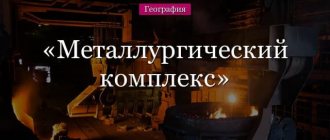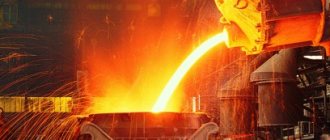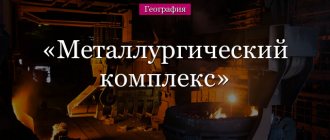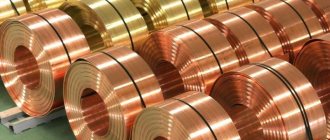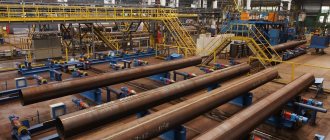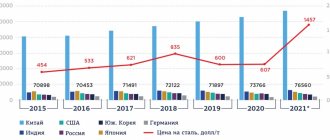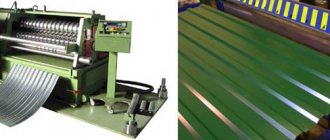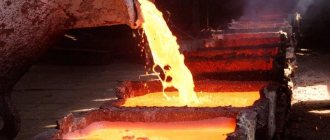Factors in the location of ferrous metallurgy are determined mainly by the geography of mineral deposits necessary for the metallurgical process. From the standpoint of economic feasibility, metallurgical plants appear in the vicinity of iron ore deposits. This is a general rule.
However, there are exceptions to this. The absence of coal basins and powerful power plants near iron ore deposits excludes the possibility of building a metallurgical plant in such an area. Ideal conditions are considered to be the concentration of all factors in one place: the presence of ore, coal and electricity.
The choice of area for the construction of a metallurgical plant plays an important role, because new cities grow around the new enterprise, infrastructure develops, and the economic activity of small businesses increases. Most metallurgical plants play a city-forming role in their locations.
The importance of metallurgy for economic development
Russia is one of the world leaders in steel production. The metallurgical industry of the Russian Federation constitutes a significant part of the country's gross domestic product. According to this indicator, it is second only to the oil and gas sector.
The export of metal products provides stable foreign exchange earnings to the Russian economy.
The metallurgical complex consists of ferrous and non-ferrous metallurgy. Products produced by metallurgical plants are used in a huge number of sectors of the economy. Ferrous metallurgy indirectly creates jobs in related industries.
Rolled metal is the basis of mechanical engineering and construction. In the production of many parts, housings, reinforcing elements and fasteners, steel is simply irreplaceable in terms of performance characteristics.
To understand the principles by which the location of new metallurgical plants is selected, you need to understand the features of steel production technology.
Concept and branches of the metallurgical industry
The basic industry of the Russian Federation, which determines the viability of the economy, is the metallurgical industry.
In addition, this is one of the key areas for the development of the country’s economy, since its share in GDP is 5%. Definition 1
The metallurgical industry is a branch of heavy industry that involves the processes of making metals from ores or other materials, as well as metal alloys.
The structure of the metallurgical industry includes the following processes: direct production of metals; hot and cold processing of metal products; welding; application of metal coatings.
The procedure for manufacturing metal products itself consists of three stages: mining and preparation of ore; remelting; use and disposal.
Are you an expert in this subject area? We invite you to become the author of the Directory Working Conditions
Various raw materials are used in the metal production process. Depending on what kind of raw materials are used, ferrous and non-ferrous metallurgical industries are distinguished. The first category includes metals that include iron, manganese and chromium. The other group includes all other metals.
Definition 2
The ferrous metallurgical industry refers to the extraction from the depths of the earth and subsequent processing of ferrous metal ores, as well as steel and iron foundries, rolling of billets and the production of iron alloys.
The products that are produced at metallurgical plants are: the main (or final product); by-product (or that which appears during the manufacture of main products); by-products (or those products that remain after the production of main and by-products and can be used as secondary raw materials).
The main products of the ferrous metallurgical industry are rolled metal, cast iron, hardware, etc.
Finished works on a similar topic
Course work Metallurgical industry 440 ₽ Abstract Metallurgical industry 260 ₽ Test paper Metallurgical industry 190 ₽
Receive completed work or specialist advice on your educational project Find out the cost
If we compare ferrous with non-ferrous metallurgy, a lot of energy is spent in the production of non-ferrous metal products. This is explained by the low content of useful substances in non-ferrous metals and large volumes of waste, which require certain methods of disposal.
The main types of non-ferrous products are long products and sheet metal.
Features of the metallurgical process
A metallurgical plant is an enterprise with a full metallurgical cycle, including all three stages of the metallurgical process: iron smelting, steel production, rolling.
There are two types of metallurgical plants:
- plant producing steel and rolled products;
- a plant where iron and steel are produced.
The technological process for the production of steel and rolled products is a complex sequence, the stages of which are as follows:
Mining of iron ore, coking coal and limestone;
- ore dressing at mining and processing plants;
- coal coking;
- smelting cast iron in blast furnaces;
- steel production in oxygen converters or open-hearth furnaces;
- rolling steel ingots on crimping mills;
- rolling of blooms and slabs on section rolling, sheet rolling and pipe rolling mills.
The production of rolled metal is impossible without the presence of powerful energy resources. This factor stimulates the development of the electric power industry and other related sectors of the economy. Russia's electric power potential ensures the production of steel and rolled metal at dozens of factories and mills.
The blast furnace process requires specific carbon-containing fuel. This need is met by coke production.
The factors for locating ferrous metallurgy enterprises are determined by its basis – raw materials.
Factors of location of ferrous and non-ferrous metallurgy
If we consider the general factors for the location of metallurgical industries, we can distinguish three types of metallurgical bases in Russia:
- a base that works with its own ore and coal;
- a base that uses either its own or imported ore, or works simultaneously with both types;
- a base that operates near coal deposits or close to potential and actual consumers
The main factors that influence the location of metallurgical centers are:
- consumer (proximity of large steel consumers - machine-building complexes);
- environmental (outdated enterprises that use a “dirty” method of manufacturing products - the blast furnace process);
- transport (due to the distance from fuel sources, enterprises use imported ore and coal)
- raw materials (enterprises that are located directly next to the location of the ore).
The basis for the development of mechanical engineering and metalworking is the ferrous metallurgy industry. Its products are used in almost all sectors of the economy. Russia is one of the top five global producers of ferrous metals along with the USA and Japan. We have already completed an essay
Russia and Japan in more detail, China and Germany.
The production base of ferrous metallurgy consists of full-cycle enterprises: cast iron - steel - rolled products, as well as plants that produce cast iron - steel, steel - rolled products and separately cast iron, steel, rolled products.
The factors for locating ferrous metallurgy enterprises are quite diverse. Special factors are highlighted in the production of electric steels and ferroalloys. Russia is sufficiently supplied with raw materials for ferrous metallurgy, but iron ores and fuel are unevenly distributed throughout the country.
Figure 1. Main factors for locating ferrous metallurgy enterprises. Author24 - online exchange of student work
Non-ferrous metallurgy in Russia is developing on the basis of the use of its own large deposits of various ores of non-ferrous, noble and rare metals, as well as diamond mining. The Russian Federation ranks second after the United States in the production of non-ferrous metallurgical industry products. The industrial structure includes 47 mining enterprises, of which 22 are in the aluminum industry. More than 70 different non-ferrous metals are produced in Russia.
In the territorial organization of non-ferrous metallurgy enterprises, the orientation towards raw materials is clearly expressed. This is due to the wide variety of raw materials and materials mined for the production of non-ferrous products.
Figure 2. Main factors for locating enterprises in the non-ferrous metallurgical industry. Author24 - online exchange of student work
Raw material base
Domestic metallurgy is developing thanks to the wealth of minerals that fill the bowels of the state.
Numerous deposits of coking coal fully satisfy the needs of metallurgists. Most Ural plants operate on coal supplied from the Kuznetsk coal basin (Kuzbass).
In terms of iron ore reserves, the Russian Federation is now in first place in the world. Its territory contains about 19% of the world's reserves of this mineral. Large deposits of iron ore are called an iron ore basin. The largest examples of them in the post-Soviet space are:
- Krivoy Rog iron ore basin;
- iron ore basin of the southern Urals;
- Kursk magnetic anomaly.
Experts develop iron ore deposits using open (quarry) and underground (mine) methods.
The feasibility of developing deposits of coal or ferruginous quartzite is determined by the depth of the deposits, transport accessibility of the deposit, as well as technological parameters.
Having considered the factors (not only raw materials) influencing the choice of location for metallurgical plants.
Geography
What is combination? Where are the largest Russian coking coal deposits located?
Supply of raw materials. Ferrous metallurgy enterprises are engaged in the extraction and processing of iron ore and the production of ferrous metals. Ferrous metals account for 90% of all metals used in the Russian national economy. Alloys of iron and carbon (cast iron, steel, ferroalloys) are most widely used. Russia is fully supplied with iron ore for ferrous metallurgy. Russia's share in the world's proven reserves of iron ore is 32% (57 billion tons), and annual production is 15% of the world. Iron ore is mined at the deposits of the Kursk Magnetic Anomaly (KMA), the Urals, Karelia, the Kola Peninsula, and Siberia. At the same time, about 80% of iron ore is mined in open pits in large open pits. Russia exports 1/5 of the iron ore produced to other countries.
There are not enough manganese and chromium ores in Russia, so our country is forced to buy them in other countries: manganese ore - in Kazakhstan, Ukraine, Georgia, chrome ore - in Kazakhstan. Coking coal is brought to ferrous metallurgy enterprises mainly from Kuzbass and the Pechora coal basin.
Ferrous metal production technology. There are two ways to obtain ferrous metals: blast furnace and blast furnaceless.
The basis of blast furnace metallurgy is a sequential technological chain: ore - cast iron - steel - rolled products. Pig iron is smelted in blast furnaces from iron ore and manganese ore added to it. The fuel is coke, which is produced at coke plants from coking coal (Fig. 28, a).
Rice. 28, a. Scheme of a metallurgical plant (blast furnace metallurgy)
In blast furnaces at high temperatures, CO gas is formed from coke and oxygen in hot air, which frees iron from oxygen. The reduced iron is combined with carbon, resulting in cast iron, which contains 2-4% carbon. Due to the admixture of carbon, cast iron is very brittle, so when re-melted, the carbon is burned out to 0.2-2% and a stronger steel is obtained. To improve the quality of steel, metals are added to it (vanadium for vibration resistance, molybdenum and cobalt for heat resistance, tungsten and nickel for hardness).
Steel is smelted from cast iron and scrap metal in open-hearth furnaces and converters. Recently, instead of open-hearth furnaces, a more advanced oxygen-converter method is increasingly being used, in which oxygen is injected into a container with cast iron and scrap metal. Melting in converters takes about 30 minutes (instead of 8-10 hours in open-hearth). Rolled steel is produced from steel in rolling mills.
Blastless metallurgy (electrometallurgy) is the production of steel by direct reduction of iron without the use of coal. The source of heat is a powerful charge of an electric arc (electric current), which heats the metal to t = 5000 °C (Fig. 28, b). The first electrometallurgical plant in Russia began operating in the city of Stary Oskol.
Rice. 28, b. Steel smelting in electric arc furnaces (blastless metallurgy)
High-quality steel is smelted in electric arc furnaces: the metal in an arc furnace does not come into contact with gases and is purer than in an open-hearth furnace. After loading scrap metal and other metals, carbon electrodes are lowered into the furnace and the current is turned on. An electric arc occurs between the electrodes and the metal, due to which, after a short time, “puddles” of molten metal appear around the carbons. The purest carbon-free alloys are produced in induction furnaces. Under the influence of an electromagnetic field, the metal in the furnace is vigorously stirred, and chemical reactions are accelerated. Steel smelted in such furnaces is more homogeneous than that produced in open-hearth and arc furnaces. The carbon content in it does not exceed hundredths, or even thousandths of a percent.
Types of ferrous metallurgy enterprises and factors of their location (Table 6). The majority of ferrous metallurgy enterprises are full-cycle metallurgical plants (combines), where the entire chain of technological processes (cast iron - steel - rolled products) is carried out. If the plants are located near iron ore deposits, they include iron ore mining and processing plants. Waste rock obtained during ore beneficiation, as well as metal production waste (slag), are used to produce building materials. The plant also includes a coke plant that produces coke.
Ferrous metallurgy is characterized by a high concentration of production that developed during the Soviet period. 30 monopolistic enterprises (10% of all enterprises) produce 2/3 of the total output of the industry. Concentration significantly reduces production costs. However, at the same time, transport costs for transporting finished products increase, and the burden on nature increases.
There are also incomplete cycle metallurgical plants: blast furnace plants (smelt cast iron), steel foundries (pouring steel), conversion plants (produce steel and rolled products, often from scrap metal), rolling mills (produce rolled products), pipe rolling plants (pipes), ferroalloy plants (production of iron alloys with alloying metals).
Small metallurgy plants produce steel and rolled products in the foundries of large machine-building plants.
Rice. 29. Steelmaking
Conversion plants gravitate towards large machine-building centers, which are at the same time the main consumers of metal and suppliers of scrap metal. Melting scrap provides a very large economic effect: 1 ton of steel obtained from scrap metal costs 5-7 times less than steel smelted from cast iron.
Table 6
| The degree of influence of raw materials, fuel and energy, and consumer factors on the location of metallurgy enterprises | |||
| Enterprises | Placement factors | ||
| Raw materials | Fuel and energy | Consumer | |
| Blast furnace plant, plant | ++ | ++ | — |
| Conversion plant | ++ | — | ++ |
| Electrometallurgical plant | ++ | +++ | — |
| Small metallurgy plant | — | — | +++ |
Geography of ferrous metallurgy (Fig. 30). The oldest and most powerful region of ferrous metallurgy, the Ural region, produces 40% of the country's total Russian production of steel and rolled products. 1/5 of Russia's iron ore reserves are concentrated in the Urals, but large deposits have already been developed. The main part of the ore (2/3) is imported from the Kursk magnetic anomaly, from the Kola Peninsula, from Kazakhstan. The largest deposit in the Urals, Kachkanarskoye, has a low iron content in the ore (17%). According to experts, in 10-20 years iron ore will no longer be mined in the Urals. Coking coal is brought from Kuzbass. The largest enterprises are located in Nizhny Tagil, Magnitogorsk, Chelyabinsk and Novotroitsk.
Rice. 30. Geography of ferrous metallurgy
The European Center is inferior to the Urals in terms of production scale (20% of the all-Russian production of steel and rolled products). 2/3 of Russia's iron ore reserves are located here. The largest deposit is the Kursk magnetic anomaly with high quality ore (45% of metal in the ore). A significant amount of metal is smelted from scrap metal. All necessary coal is imported. It is in the European Center that the main consumers of metal (machine-building enterprises) are concentrated. Large centers of metallurgy are Lipetsk, Tula, Stary Oskol.
The European North has almost caught up with the European Center in terms of the scale of ferrous metallurgy (20% of the all-Russian production of steel and rolled products). Iron ore is mined on the Kola Peninsula and in Karelia (Kostomuksha), coking coal is mined in the Pechora basin. The main center of metallurgy is Cherepovets.
Siberia accounts for 16% of all-Russian steel and rolled products production. Ferrous metallurgy is developing on its own reserves of coal (Kuznetsk basin) and iron ore (deposits of the Angara region and Gornaya Shoria). The largest metallurgical center is Novokuznetsk.
Metallurgy in the eastern part of the country is still poorly developed. The Far Eastern Metallurgical Plant is being designed, which will operate on the iron ore and coal reserves of Southern Yakutia.
Let's sum it up
• Ferrous metallurgy enterprises are characterized by high concentration of production.
• Most Russian products are produced at full-cycle metallurgical enterprises (plants). There are also part-cycle plants and small-scale metallurgy plants.
• The location of full-cycle plants and blast furnaces is strongly influenced by raw materials, fuel and energy and transport factors. Therefore, these enterprises are located near resource bases or at the intersection of transport routes. The energy factor has a decisive influence on the location of ferroalloy and electrometallurgy plants. Processing and small-scale metallurgy enterprises are located in areas with developed mechanical engineering and a skilled workforce and are consumer-oriented.
• The largest regions of ferrous metallurgy are the Urals, the European Center, the European North, Siberia.
Questions and tasks
1. Using fig. 7 and the text of § 2, remember in what historical period ferrous metallurgy became the leading industry in the technological cycle and when it began to actively develop in Russia. 2. What impact did the development of metallurgy have on the formation of other industries in our country? 3. Prove that metallurgical plants have a powerful area-forming effect on the development of the territory. What technological features of ferrous metallurgy is this connected with? 4. Why are metallurgical plants polluters of the natural environment? 5. Using fig. 30 determine the patterns of location of ferrous metallurgy enterprises in Russia. 6. Think about in which areas of the country it is possible and necessary to build metallurgical mini-plants (widespread abroad), working on scrap metal and quickly taking into account consumer demands.
- Previous
- Table of contents
- Next
Criteria for choosing the location of metallurgical enterprises
The greatest economic effect is achieved when enterprises and interrelated industries are concentrated in one territory. This gives metallurgical plants significant savings on transportation costs.
It also greatly simplifies the organization of production management:
- Metallurgical plants, due to their technology, require large volumes of water resources. This makes it mandatory for them to be located near bodies of water.
- The environmental factor is also important. Metallurgical plants cannot be built near environmental protection zones. Their design must take into account the wind rose of each specific area.
- Electrometallurgical plants require large amounts of electricity and scrap metal to operate. Such enterprises are usually built near powerful hydroelectric power stations.
Industrial zones with metallurgical plants should be located at a reasonable distance from residential areas. Under the influence of these factors, design institutes are developing new metallurgical enterprises that comply with all environmental protection standards.
Among the many factors for the location of ferrous metallurgy, a special place is occupied by its proximity or distance from large river and sea ports. Export deliveries are most feasible when products are shipped by sea, which is the cheapest. Proximity to the river system is one of the main requirements for the construction site of a metallurgical plant.
Ferrous metallurgy
Metallurgy development centers in Russia
Most Russian metallurgical enterprises are located in the Urals. This region accounts for up to half of the total volume of steel produced. The main industry giants are located in Magnitogorsk, Chelyabinsk and Nizhny Tagil.
In the European part of Russia, large plants are located in Lipetsk, Cherepovets and Stary Oskol. In the latter, by the way, there is the only electrometallurgical plant in Russia.
In the West Siberian region, metallurgical production is represented by two large plants in Novokuznetsk. The factors for the location of metallurgy in Siberia are determined by the presence of cheap Kuzbass coal in this territory.
The geography of the location of metallurgical enterprises is quite extensive. The general rule for the three named centers of metallurgy is the attraction to sources of raw materials and fuel.
Metallurgy of non-ferrous metals has its own characteristics.
How does this industry differ from ferrous metallurgy in terms of its location factors?
Ferrous metallurgy
Ferrous metallurgy
is a basic industry in Russia.
A significant part of the metals produced in the country is exported. The increase in metal exports is largely due to a reduction in their domestic consumption due to a sharp decline in production in certain branches of mechanical engineering and, above all, the defense industry.
Ferrous metals are those based on iron (cast iron, steel, ferroalloys). 90% of all metals used in modern production are ferrous metals
. The starting materials for ferrous metallurgy are iron, manganese and chromium ores.
An additional and very large raw material base for the industry is made up of scrap metal resources (depreciation scrap, metallurgical waste, etc.). In addition, metallurgy consumes a large amount of fuel (mainly coking coal).
The Russian ferrous metallurgy is based primarily on its own raw materials and includes the extraction of iron ore, smelting of iron and steel, and the production of rolled products and ferroalloys.
Iron ore
is a mineral formation whose main component is iron.
Russia's share in world iron ore reserves is 18% (57 billion tons).
Iron ore reserves in Russia
And their annual production in the country is one hundred million tons (3% of the world). The domestic metallurgy is provided with its own iron ore for at least a century. But 90% of the mined ore has a low iron content. And Russia almost entirely imports manganese and chromium: manganese from China and Ukraine, and chromium from Kazakhstan.
Iron ores are usually classified according to their iron content: rich, ordinary and poor.
Ore with a high iron content (more than 40%) is suitable and economically profitable for industrial mining.
All rock mining methods can be divided into two main types: open (quarries) and closed (mines). The open method of mining causes greater damage to the environment, in contrast to the closed method. But its use requires small capital investments. Ore, which lies shallow in the earth's crust (up to 500 meters), is extracted by open-pit mining.
When developing quarries, explosion technology is used to remove rock more easily. The explosion occurs in a fraction of a second and is capable of destroying large areas of rock. During blasting operations, the quality of the ore does not suffer in any way.
The largest quarry not only in Russia, but throughout the world is located in the Belgorod region, between Stary Oskol and the city of Gubkin.
It is called Lebedinsky, it was twice included in the Guinness Book of Records for the size of the quarry and for the volume of production of non-combustible minerals. The depth of the quarry is 450 m, the diameter is 5 km, it is estimated that 14.6 billion tons of iron ore lie here, about 133 units of machinery operate per day, one dump truck is capable of delivering up to 200 tons of ore.
Lebedinsky quarry
Mining ore using the mine method is quite expensive, since it requires a certain infrastructure, as well as the creation of safe conditions for the work of people and equipment. There are frequent cases of displacement of the earth's rock and collapse of mines, their flooding and other disasters. Therefore, this method is not used in Russia when the ore contains a small percentage of iron. Although manufacturing industry technologies are constantly developing and provide opportunities for more productive enrichment of ores containing iron in small quantities.
The territorial organization of ferrous metallurgy is influenced by:
1. Concentration of production.
This is an increase in the number of large enterprises and the concentration on them of an increasingly large part of the means of production, workers and output.
Full-cycle metallurgical plants in Lipetsk, Cherepovets, Magnitogorsk, Nizhny Tagil, Novotroitsk, Chelyabinsk and Novokuznetsk produce more than 90% of pig iron and about 89% of Russian steel.
Metallurgical plants of Russia
2. Production combination, meaning the unification at one enterprise of several interrelated industries of various industries.
3. Material intensity of production.
4. High energy intensity, which is higher than in developed countries of the world.
5. High labor intensity.
6. When placing, the provision of transport routes is also taken into account, because a modern metallurgical plant receives and sends the same amount of cargo as a large city, so it cannot work without a railway.
7. The need to protect nature (the industry accounts for 15% of industrial emissions into the atmosphere).
The production base of ferrous metallurgy consists of full cycle enterprises: cast iron - steel - rolled products.
Rental
– the final, most valuable product of the entire ferrous metallurgy cycle. Its cost is 2-5 times more than the cost of the steel from which it is made. Rolled products are very diverse (up to 20-30 thousand types and names).
Rental
It is most profitable to create metallurgical enterprises:
1) near sources of raw materials (Ural, Norilsk);
2) in areas of coking coal mining (Kuzbass) or cheap electricity production (Eastern Siberia);
3) at the intersection of ore and coal flows (Cherepovets).
Under the influence of all the factors considered, metallurgical enterprises are located throughout the country not evenly, but in clusters, called the main metallurgical bases.
Main metallurgical base
- a group of metallurgical enterprises that use common ore or fuel resources to produce large quantities of metal.
In the ferrous metallurgy in Russia there are four metallurgical bases: the Urals, the European Center, the European North and Siberia.
Metallurgical bases of Russia
Each of them has its own characteristics of provision of raw materials, fuel, electricity, set and capacity of production.
Ural metallurgical base
- a leading base for the production of ferrous metals (slightly less than 50% of steel and rolled products). It has large reserves of iron ore (15 billion tons, or 24% of all-Russian reserves).
The average iron content in Ural ore is very low (21%), and at the largest deposit of the Urals - Kachkanarsky - 17%.
However, rich deposits have already been developed, so 2/3 of it is imported from Kazakhstan, from the Kola Peninsula, and the Kursk Magnetic Anomaly (KMA). Coking coal is brought here from Kuzbass.
Historically, on the basis of the once richest Ural deposits, several dozen metallurgical plants of various sizes arose. Many of them still exist today. But the bulk of the metal is produced at four largest enterprises located in Nizhny Tagil, Magnitogorsk, Chelyabinsk and Novotroitsk. All Ural enterprises are very old and need reconstruction. They still produce metal of not very high quality and heavily pollute the environment.
European Center
In terms of production scale it is inferior to the Ural base; it produces about 20% of steel and rolled products. However, it is here that the bulk of the country’s iron ore reserves are concentrated (2/3 of the total Russian reserves). High-quality ore containing 45% iron is mined mainly by open-pit mining. The main reserves are almost entirely concentrated in the Kursk magnetic anomaly, the world's largest iron ore deposit. In addition, there is a lot of scrap metal, which is a promising raw material for the industry. Large centers of metallurgy are Lipetsk and Stary Oskol. In Stary Oskol there is the only enterprise in Russia where metal is produced using new (blast-free) technology.
European North
in terms of production volume it is almost equal to the Center; it produces about 20% of steel and rolled products. Iron ore is mined on the Kola Peninsula and in Karelia (near the city of Kostomuksha), coking coal is mined in the Pechora basin. The main center of metallurgy is Cherepovets.
Siberian metallurgical base
, whose share in the production of steel and rolled products is slightly less than 15%. It develops on Kuznetsk coal and iron ore deposits of the Angara region and Mountain Shoria. They are used by two metallurgical enterprises in Novokuznetsk.
In the future, it would be advisable to form another base in Russia - the Far Eastern
, since importing metal here from other areas is very expensive. The resource basis for this base could be a unique combination of iron ore from the Tayozhnoe deposit and Chulman coal.
Features of non-ferrous metals production
A distinctive feature of non-ferrous metal smelting plants is the high level of environmental pollution from their activities and the high energy intensity of the technological process.
Non-ferrous metals are distinguished by the diversity of their deposits. The geography of non-ferrous metal deposits is very extensive. “Give examples,” the majority of the population will say. These are mountains, rivers, and large ore deposits on the ground and underground. Gold and rare earth metals “live” in the sands. People can provide examples of some copper mines in the Urals, where copper is extracted from groundwater.
The metallurgical process for the production of non-ferrous metals is similar to the same process in ferrous metallurgy, although it has its own characteristics. The technological chain for the production of non-ferrous metals is as follows:
- ore mining and beneficiation;
- smelting in high temperature furnaces;
- pressure treatment.
Geography of Russian ferrous metallurgy lesson plan on geography (9th grade) on the topic
Lesson topic: Geography of ferrous metallurgy
Goals:
1. Define the concept of “metallurgical base”.
2. Introduce students to the main bases for locating ferrous metallurgy enterprises.
Equipment: map “Metallurgy”, map of the Russian Federation, collection “Ferrous Metallurgy” (coal, coke, iron ore - magnetic, red, brown, cast iron, steel).
During the classes:
- Organizing time.
- Checking homework.
In the last lesson we got acquainted with the metallurgical complex. Let's remember.
1. What is the metallurgical complex, its significance and role in the national economy of the country?
(The metallurgical complex is a set of industries producing a variety of metals. Its main economic function is the production of a variety of structural metals).
The metallurgical complex consists of two large branches of ferrous and non-ferrous metallurgy. They have many similarities, but there are also significant differences.
2. Tell us about the types of ferrous metallurgy enterprises, what is their difference?
(Full cycle plant - located near raw materials and fuel or on ore and fuel flows; includes three production shops: blast furnace + steelmaking + rolling.
Limit factories and small metallurgy plants focus on scrap metal - this is waste from machine-building plants, and therefore are located in large cities, focusing on the consumer).
3. What raw materials are supplied to the metallurgical plant?
(Iron and manganese ores, coking coal, gas, water, limestone)
4. Create a technological chain for the production of “ferrous metallurgy”
Extraction of raw materials (in quarries and mines) beneficiation of raw materials (at Goki) smelting of cast iron (in blast furnaces) smelting of steel (in steel-smelting furnaces; cast iron + ferroalloys + O2) production of rolled products (in the rolling shop on rolling machines sheets, rails, angles, pipes)
This is the original plant where not only metal is produced, but also raw materials are prepared and waste is processed.
- Problem
The Ministry of Fuel Industry is waiting for your solution to the following problem:
Attention! “To ensure supplies of oil and gas to Europe, more than 100 million tons of large-diameter steel pipes were laid in Russia, forming the basis of a unique pipeline system. Most of these pipes have been in operation since the 70s of the last century, when 2-3 million tons of large-diameter pipes were purchased in Europe and Japan. The service life of these pipes is 30 years and is already ending.
We have to replace these pipes on the same scale. Today Russia has a chance to correct the paradoxical situation when the world's largest consumer of large-diameter pipes and at the same time one of the world leaders in steel production does not have modern pipe production.
There was a need to build a plant for the production of large-diameter pipes.
Where is it more convenient and profitable for us to build it?”
While studying new material, we will try to solve the problem and help the Ministry of Fuel Industry.
- Learning new material
Today in class we continue to look at the metallurgical complex.
Lesson topic: Geography of ferrous metallurgy.
During the lesson we work according to the following plan:
1. Areas of location of ferrous metallurgy enterprises.
2. Factors of location of ferrous metallurgy enterprises.
3. Practical work “Characteristics of metallurgical bases in Russia.”
First you need to understand what ferrous metals are. Ferrous metals are those based on iron (cast iron, steel, ferroalloys). They make up 89% of all metals used in modern production. The production of ferrous metals requires iron ore, chromium, manganese, coke and other components. Russia's share in world iron ore reserves is 32%, and their annual production in the country is 15%.
The Russian metallurgy is provided with its own iron ore for at least a century. But 90% of the mined ore has a low iron content.
Therefore, it is most profitable to create metallurgical enterprises:
1) In ore mining areas (Ural)
2) In areas of coking coal mining (Kuzbass)
3) In areas where cheap electricity is produced (Eastern Siberia)
4) We must not forget that this is a water-intensive and “dirty” production.
Based on the characteristics of the location of enterprises, we can name the factors for their location:
1. Raw materials
2. Fuel
3. Transport
4. Water and energy
5. Ecological
Taking into account all these indicators, metallurgical enterprises are located unevenly throughout the country, but in clusters called metallurgical bases.
A metallurgical base is a group of metallurgical enterprises that use common ore and fuel resources to produce large quantities of metal.
There are three metallurgical bases on the territory of Russia:
- Ural
- Central
- Siberian
Now, using the atlas and textbook, we will perform (in groups) practical work on the topic: “Characteristics of the main metallurgical bases.”
Each base has its own characteristics of supply of raw materials, fuel and energy.
| Group I | Group II | III group | |
| Criteria | Ural | Central | Siberian |
| 1. Base location | |||
| 2. Share of the region in the all-Russian production of rolled products, in% | 45 | 40 | 13 |
| 3. Sources of raw materials | Kachkanarskoe (Ural), Sokolovsko-Sarbaiskoe (Kazakhstan), KMA | KMA, Kostomuksha, Monchegorsk, Kandalaksha | Korshunovskoe, Temirtau, Tashtagol |
| 4. Fuel sources | Kuzbass, Kazakhstan | Pechora basin, Donbass (Ukraine) | Kuzbass |
| 5. Large centers | Nizhny Tagil, Magnitogorsk, Chelyabinsk, Novotroitsk, Serov | Cherepovets, Lipetsk, Stary Oskol, Tula | Novokuznetsk, Krasnoyarsk, Belovo |
| 6. Problems |
Conclusion:
Each group has its own theorists and practitioners (history, problem).
- Group I – Ural metallurgical base
(history, characteristics, base problem)
- Group II – Central metallurgical base
(history, characteristics, base problem)
We did a little research.
The Pechora coal basin is located in the northeast of the Komi Republic. The center of the basin is the city of Vorkuta, located behind the SEC, and another city in the basin is the city of Inta.
There is a railway to Vorkuta, called Pechorskaya (Konosha-Vorkuta), which passes through the city of Mikunall trains pass through our station.
We found out that there should be 3 trains with coal per day; 1 train consists of 56 cars. The carrying capacity of one carriage is 67 tons, and then simple mathematics, therefore, one train transports 3752 tons of coal. In total, 11,256 tons of coal are transported per day.
We managed to take a photo where we can see how empty cars are being transported to Vorkuta, and a full train with coal is heading to the city of Cherepovets.
We also found that 200-250 cars (north + south) arrive at the metallurgical plant in the city of Cherepovets per day.
We are interested in this information and will continue to study it further.
- Group III – Siberian metallurgical base
(history, characteristics, base problem)
Features of the area.
A promising area for the construction of a full-cycle metallurgical plant. The most promising is the construction of a plant in the city of Neryungri, the Chulman deposit of the South Yakutsk Taezhnoe coal basin. The Tynda-Aldan railway passes through Neryungri.
TPP – Chulmanskaya, Neryungrinskaya.
- Conclusions:
1. the resources of the Ural base have already been depleted;
2. the central base came out on top;
3. The future of Siberia is “just around the corner”
At the beginning of the lesson we were given a problem.....
Where do you think is more profitable to build a plant for the production of large-diameter pipes?
This problem actually occurred in the Russian economy. This is a construction project. On April 26, 2005, the government signed a decree on the creation of JSC Plant for the Production of Large Diameter Pipe, which puts an end to this problem. An agreement was signed with Gazprom for the supply of pipes from Nizhny Tagil.
- Reinforcing the material learned
- Select ferrous metals from the list (iron, chrome)
- Select two factors for the location of ferrous metallurgy enterprises that are the main ones (fuel, raw materials)
- Select the largest centers of ferrous metallurgy in Russia (Magnitogorsk, Nizhny Tagil)
- Select fuel sources for the Russian Central Base (Pechorsky, Donbass)
Criteria for choosing the location of non-ferrous metallurgy facilities
The geological factor is the main criterion influencing the location of plants for the production of non-ferrous metals. Due to the low proportion of useful components in non-ferrous metal ores, their transportation is not economically feasible.
This requires the location of factories in this industry in mining areas. Nickel production, for example, is strictly tied to the place of its extraction.
Such factors lead to the fact that production is located in unfavorable climatic conditions - in the Arctic Circle (Norilsk).
The development of non-ferrous metal deposits is often associated with a number of difficulties. Access to useful minerals is often blocked by a shield of waste rock and must be blasted. Such development requires the use of a large amount of equipment: excavators, conveyors, electric locomotives.
Non-ferrous metallurgy
Metals in which iron is not predominant are usually called non-ferrous. This category includes various alloys containing nickel, magnesium, aluminum, etc. The industry that includes the extraction and processing of non-ferrous metals and their alloys is called non-ferrous metallurgy. In terms of production size, it is one of the ten largest economic sectors in the country.
Non-ferrous metals are classified into the following types:
- lightweight (have a wide range of applications) - this includes aluminum, magnesium;
- heavy (used in the chemical and technical industries) - nickel, lead;
- noble alloys (used in jewelry) - platinum, gold;
- refractory (area of use: instrument making, mechanical engineering) – tungsten, tantalum;
- metals with a high level of radioactivity - polonium, radium, uranium (used in nuclear power plants, nuclear installations);
- dispersed metals - rubidium, germanium, gallium (used in lighting technology, vacuum technology);
- rare earths - scandium, lanthanum, lanthanides (fields of application include glass melting, nuclear energy, electronics, medicine).
Factors influencing the location of non-ferrous metallurgy enterprises: proximity to sources of raw materials, climatic conditions in the region, opportunities for development.
Volume and features of production
The volume of production of non-ferrous metallurgy products is increasing from year to year. The industry is actively developing, new technologies and processing methods are appearing. About 40% of nickel and 20% of aluminum are produced in Russia. On average, 70% of metals are exported. Therefore, this industry plays an important role in the Russian economy. The main feature of non-ferrous metallurgy is the high cost of obtaining and processing raw materials.
Rolled metal or rolled metal is a product made of metal that is subjected to special processing, during which it acquires the desired properties.
The main volume of transport supplies is carried out to non-CIS countries (90-95%). In terms of the amount of metal products produced in the country, non-ferrous metallurgy is clearly inferior to ferrous metals, but the price of non-ferrous metals is much higher. A positive result from the development of non-ferrous metallurgy will be if production enterprises are located near inexpensive sources of energy resources.
Placement factors
The energy factor is taken into account in the production of light non-ferrous metals. Their production uses a large amount of electricity. Often, non-ferrous metallurgy enterprises are located near hydroelectric power plants, which generate affordable electricity.
When determining the location of production sites, the raw material factor must also be taken into account. The environmental factor, despite the increased level of danger of enterprises, unfortunately, is practically not taken into account. The impact of non-ferrous metallurgy on the environment is an important problem that needs to be addressed comprehensively.
Geography of non-ferrous metallurgy
Metallurgy of non-ferrous metals is developing not only in our country. The richest reserves of non-ferrous ores are located in Chile, India, Peru, and Venezuela. To increase the efficiency of development, enterprises from different countries cooperate with each other. The aluminum industry plays a major role in non-ferrous metallurgy. A significant part of the ore of this metal is concentrated in the zone near the equator. But successful development of this industry is possible only in those countries where there are sources of affordable energy. Non-ferrous metallurgy development centers:
- Norway;
- Russia;
- USA;
- Canada.
These countries have enough reservoirs with powerful, productive hydroelectric power stations.
In countries such as France, Hungary, Austria, which have expensive energy and where aluminum smelting is a common type of industry, the production of this metal is gradually decreasing.
Impact of non-ferrous metallurgy on the environment
The first stage in the development of non-ferrous metallurgy was the Bronze Age. But in those days, this industry harmed the environment much less than it does today, because... Primitive but safe methods of extraction and processing of raw materials were used; there were no large enterprises that emit tons of harmful substances into the air.
Every year, about 3,000 tons of harmful substances are released into the atmosphere. Sources of harmful emissions in production are various types of furnaces (for smelting, roasting, induction, etc.), open storage areas and drying machines.
Every year, the non-ferrous metallurgy uses about 1200 million tons of fresh water. Wastewater is contaminated with minerals and photoreagents, which contain toxins.
The most powerful sources of pollution are large non-ferrous metallurgy plants, since they have a predominant open method of extracting raw materials and the soil suffers because of this.
Industry development prospects
The rate of increase in demand for metal products will be estimated at at least 3% per year (referring to the first option) and at least 5% per year (referring to the second option). Write about these options
- With a conservative development of events, the production of non-ferrous metals in 2022 will increase by 25.3%, and in 2030 - by 41.6%.
- Under the innovative scenario, the production of non-ferrous metals will increase by 28.5% this year alone, and by 49.7% in 2030.
In 2030, the implementation of major projects is being considered, including the modernization of factories, the development of new copper ore deposits, and the construction of zinc plants.
From ancient times to the present day, metal has been the main construction material. Recently, thanks to scientific and technological progress, the specific gravity of the metal has been reduced in many industries. But still, it plays an important role in the development of the economy of any country.
Problems and prospects for the development of metallurgy in Russia
A common problem of the Russian metallurgical complex is the need for modernization and technical re-equipment.
Domestic metallurgical enterprises are faced with the task of reducing the energy intensity of their production. The rapid growth of metallurgy in China requires Russian manufacturers to take effective measures to reduce costs.
Reducing costs while maintaining the quality of products is the only way to be competitive manufacturers in the global steel parts market.
Metallurgy in the Far East will develop thanks to iron ore deposits in the Aldan province and the discovery of coking coal deposits in Yakutia. The construction of full-cycle metallurgical enterprises in the Far East is due to the need to reduce the cost of metal for the local machine-building plants.
Railroad deliveries significantly increase the cost of rolled steel. This factor plays a negative role in the competitiveness of metal-intensive enterprises in the Far East.

